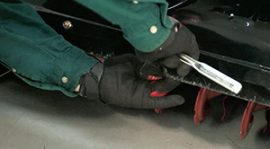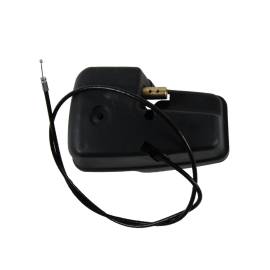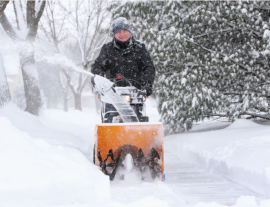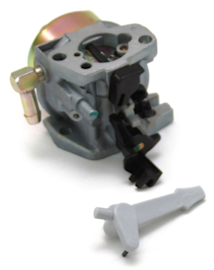How to adjust the snowblower shift cable


When your snowblower fails to move properly in all of the forward and reverse speeds, you’ll likely need to adjust the shift cable.
The shift cable attaches to the speed control lever on one end and to the index bracket. Moving the speed control lever on the control panel causes the shift cable to rotate the index bracket which adjusts transmission direction and speed.
To accurately shift snowblower speed, you’ll need to keep the shift cable tension adjusted properly.
How to adjust shift cable tension
Park the snow thrower on a level surface with the engine shut off.
Place the shift lever in the fastest forward speed position.
Loosen the hex nut on the shift cable index bracket.
Pivot the bracket downward to remove slack in the shift cable. If you’re not able to remove slack from the cable by moving the bracket downward, disconnect the shift cable from the index bracket and reconnect it in a lower hole so that you can remove slack from the shift cable.
While holding the shift cable tight, tighten the hex nut.
Test the snowblower drive performance and continue to adjust the cable until the snowblower drives properly at all selected speeds.
How to complete full snowblower maintenance
Unless you’ve recently completed a full snowblower tune-up, you can move on to additional maintenance tasks after adjusting the shift cable.
Check the auger belt and ground drive belt for wear
Remove the belt cover and check the belts for cracks, damage or excessive wear. Replace the belts if they’re worn or damaged.
Follow the directions in the owner’s manual for your snowblower to replace the belts.
Tune up the snowblower engine
Keep your snowblower engine in top shape by tuning it up at least once per season.
Drain old fuel from the snowblower
If you’ve got any fuel left in the tank from last year, drain it. Use extreme care when handling gasoline. Work in a well-ventilated area free of open flames or sparks. Fresh, clean fuel is a must. Old gas absorbs moisture when it sits for a long time in the fuel tank or your gas can. Unless you’ve used a fuel stabilizer, gas will go bad in about 6 months.
Replace the fuel filter
Old, untreated gas can clog the fuel filter in your tank, so you’ll also want to take a look at the fuel filter and replace it if it’s old or clogged. Most owner’s manuals recommend changing the fuel filter at the start of every season. Our How to Replace the Snowblower Fuel Filter video shows you how to do it.
Inspect the fuel line
Take a close look at the fuel line and make sure there are no cracks and that it's still flexible and soft. Replace the fuel line if it's cracked or broken. Our How to Replace a Snowblower Fuel Line video shows you how.
Replace the spark plug
Spark plugs should also be replaced once per season. So, if you know your spark plug is from last year, you’ll probably want to replace it. Our How to Replace a Snowblower Spark Plug video shows you how to replace and set the gap on a spark plug.
Change the oil
No tune-up is complete without an oil change. Oil lubricates the engine parts and helps cool the cylinder. Oil is another thing you should change once per season. Our How to Replace Snowblower Engine Oil video will walk you through changing the oil on a snowblower. Don't forget to take that old oil to your local oil recycling station.
Lubricate the auger shaft and housing
Lubricate the auger shaft and bearings to keep that auger from seizing up in the dead of winter. Remove all the shear pins on the auger shaft. Spray a coating of SNOW-JET silicone lubricant inside the shaft and around the spacers and flange bearings. Inspect the shear pins for wear or damage and replace them if necessary. Reinstall the shear pins and secure them with the cotter pins.
Spray the inside of the auger housing and the discharge chute with SNOW-JET to eliminate snow buildup in the chute and auger housing so you don't have to stop to clear snow from the snowblower, saving time and fuel. SNOW-JET also reduces friction, so snow blows further.
Grease the axle and check the tire air pressure
Carefully tilt the snowblower on its nose. Make sure your fuel tank is empty. Use a socket wrench to remove the first wheel. Clean and coat the axle with multi-purpose automotive grease to keep it from rusting up. Reinstall the wheel and secure it back on the axle. Repeat the process on the other wheel. Next, use a pressure gauge to check the air pressure in each tire. Press the gauge down on the valve stem to check the pressure and compare it to the recommended psi found on the tire sidewall. Inflate or deflate the tires as necessary.
Adjust the skid shoes if needed
You’re also going to want to check out both your skid shoes. The skid shoes protect the shave plate from damage. The entire bottom surface of the skid shoe should be touching the ground. If it’s not, you’ll need to adjust it. Our How to Adjust Snowblower Skid Shoes video will show you how. If your skid shoe is worn down to the point that the shave plate hits the pavement, either flip it over, or replace it.
Schedule professional snowblower maintenance service
Completing these maintenance steps can be overwhelming for some people. Instead of performing the maintenance yourself, you can have a Sears Technician do it by scheduling Snowblower Maintenance & Cleaning Service.
In addition to professionally performing the above maintenance tasks, the Sears Technician will complete these important tasks:
Check ignition system, carburetor, throttle, and choke controls.
Check the recoil starter and electric starter if so equipped.
Test the overall operation of the snowblower.
Ensure that all safety features are fully operational.
Having your snowblower professionally serviced every year will also help prevent breakdowns during the winter. Trust Sears Home Services to help you keep your snowblower or snow thrower working properly all season long.
Symptoms for gas snowblowers
Choose a symptom to see related snowblower repairs.
Main causes: punctured tire, damaged rim…
Main causes: dirty carburetor, stale fuel…
Main causes: dirty carburetor, clogged fuel filter, dirty spark plug, incorrect valve lash, leaky engine gaskets…
Main causes: stale gas, clogged carburetor, clogged or broken fuel line, dirty spark plug, bad rewind starter, incorrect…
Main causes: snow build-up in chute, chute drive mechanism failure, bad chute control assembly…
Main causes: loose drive clutch cable, damaged drive clutch cable, worn friction disc, scraper blade scraping the ground…
Main causes: clogged chute, damaged auger blades, broken shear pins, worn auger belt, damaged gear case, engine problems…
Main causes: broken shear pins, worn or loose auger drive belt, auger drive cable failure, damaged auger, bad gear case…
Things to do: replace the spark plug, change the oil, rebuild the carburetor, adjust valve lash, adjust or replace the b…
Repair guides for gas snowblowers
These step-by-step repair guides will help you safely fix what’s broken on your snowblower.

How to replace a snowblower fuel filter
Replace the fuel filter on your snowblower if it's clogged or damaged.…

How to replace a snowblower shave plate
Follow the 7 easy steps in this repair guide/video to replace a worn out shave plate on your snowblower.…

How to replace a snowblower chute control gearbox assembly
Replace the chute control gearbox on your snowblower if it's stripped or damaged.…
Articles and videos for gas snowblowers
Use the advice and tips in these articles and videos to get the most out of your snowblower.

Learn the steps to take to adjust and maintain your snowblower so it lasts longer.…

This chart will help you find the right carburetor for your Craftsman snowblower, tiller or log splitter.…

Learn how to replace the chute control assembly and gearbox if the chute on your snowblower won't turn.…